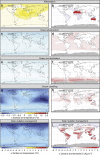Potential climate engineering effectiveness and side effects during a high carbon dioxide-emission scenario
- PMID: 24569320
- PMCID: PMC3948393
- DOI: 10.1038/ncomms4304
Potential climate engineering effectiveness and side effects during a high carbon dioxide-emission scenario
Abstract
The realization that mitigation efforts to reduce carbon dioxide emissions have, until now, been relatively ineffective has led to an increasing interest in climate engineering as a possible means of preventing the potentially catastrophic consequences of climate change. While many studies have addressed the potential effectiveness of individual methods there have been few attempts to compare them. Here we use an Earth system model to compare the effectiveness and side effects of afforestation, artificial ocean upwelling, ocean iron fertilization, ocean alkalinization and solar radiation management during a high carbon dioxide-emission scenario. We find that even when applied continuously and at scales as large as currently deemed possible, all methods are, individually, either relatively ineffective with limited (<8%) warming reductions, or they have potentially severe side effects and cannot be stopped without causing rapid climate change. Our simulations suggest that the potential for these types of climate engineering to make up for failed mitigation may be very limited.
Figures




References
-
- Peters G. P. et al.. The challenge to keep global warming below 2°C. Nat. Clim. Chang. 3, 4–6 (2013).
-
- Crutzen P. Albedo enhancement by stratospheric sulfur injections: a contribution to resolve a policy dilemma? Clim. Change 77, 211–220 (2006).
-
- Vaughan N. E. & Lenton T. M. A review of climate geoengineering proposals. Clim. Change 109, 745–790 (2011).
-
- Boyd P. W. Ranking geo-engineering schemes. Nat. Geosci. 1, 722–724 (2008).
-
- Lenton T. M. & Vaughan N. E. The radiative forcing potential of different climate geoengineering options. Atmos. Chem. Phys. 9, 5539–5561 (2009).
Publication types
MeSH terms
Substances
LinkOut - more resources
Full Text Sources
Other Literature Sources
Medical

